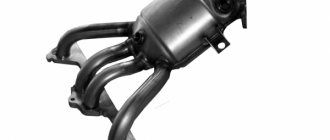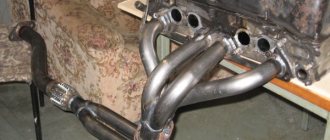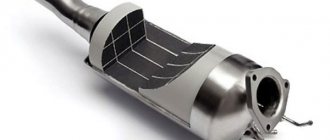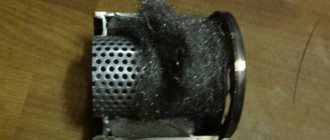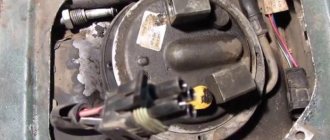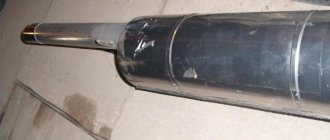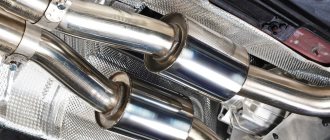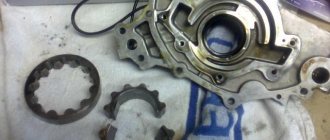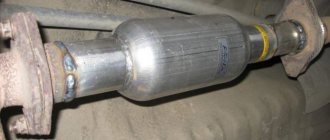The catalyst is a unit that serves to destroy nitrogen compounds that negatively affect the atmosphere and the environment. The device turns them into harmless substances - nitrogen, water and carbon monoxide.
Depending on the year of production of the VAZ 2114, they are equipped with catalysts that meet the requirements of Euro 2 or Euro 3 (2003-2008 and 2008-2013 model years, respectively).
Breakdowns and their signs
Typically, this element begins to “strange” when it travels about 150 thousand kilometers. That is, this is more likely an age-related problem with the car.
Standard and Modified
The catalyst consists of honeycombs that break down over time and do not block the release of harmful exhaust gases. The pressure in the exhaust system increases, exhaust gases go back into the engine, which leads to a significant deterioration in its performance. The engine is literally choking.
Typical signs that the catalyst is clogged are:
- The car's dynamics deteriorate significantly and noticeably;
- The engine starts with problems;
- There is a characteristic smell of sulfur in the cabin;
- The engine is unstable at idle.
If the car stops driving normally, it is advisable to immediately check the condition of this device. Alas, this cannot always be done in a garage environment, since special equipment and devices are required. But there are still two ways.
- Replace the lambda probe with a pressure gauge. Start the engine and check the pressure. If it is more than 0.5 atmospheres, things are bad.
- In the second case, you will need a remote pyrometer. If the catalyst is working normally, the temperature of the pipe before it will be higher than after it. But at the same temperature, this indicates the destruction of the honeycomb and a violation of the flame extinguishing function.
The second method allows you to obtain indirect data, so the pressure must be checked in any case. If a breakdown is detected, the catalyst must be replaced.
Replacing the device has its own characteristics depending on which engine is installed on your VAZ 2114 - eight-valve or sixteen-valve.
How to repair the exhaust system
Repair of exhaust system parts is done only if holes from mechanical impact have been discovered. If the pipe breaks and the tank burns out, it is necessary to completely replace the parts. Their warranty period has expired. It must be said that metal expansion joints are changed in any case, regardless of the condition of the exhaust system.
Due to the fact that the catalyst is very expensive, amateurs weld a stronger instead. The catalyst is cut off, leaving only the connecting flanges together with the flaring. A stronger is welded into the vacant space. This part costs much less than the catalyst. However, the stronger is not able to burn the remaining gasoline. For this reason, it can only be mounted on a car equipped with a lambda probe. After installing the stronger, gasoline consumption increases by approximately 10%.
Cars equipped with engines with 16 valves often have two metal expansion joints attached to the “pants”. The size of such corrugation does not exceed 50 mm. The cost of such a receiving pipe is incredibly high. The industry does not produce metal expansion joints of this size. The only solution is to insert a corrugation measuring 100 mm and then adjust the length. Welding is done end-to-end with the “pants” and the gasket flange.
Replacement for an 8-valve engine
If you have a VAZ 2114 with an 8-valve engine, you need to look for this element in front of the middle resonator and after the exhaust manifold directly under the bottom of the car. Many, alas, ignore the need to replace it, believing that their car will not stop polluting the atmosphere and the engine will be able to continue to operate normally. The opinion is wrong, as you understand.
Device option for eight-valve
Some believe that instead of a failed filter device, you can install a regular corrugated pipe . Also a wrong decision. This will make the noise incredibly loud, and the exhaust gases will very quickly destroy the muffler. You can get by with a budget replacement option - cut out a section of the catalyst, knock out a honeycomb of ceramics from it and perform welding, thereby sealing the body. But be prepared for noise to become your constant companion.
It is best to replace the factory catalyst with an effective flame arrester. They assemble it with their own hands or seek help at a service station, and also purchase ready-made solutions at auto parts stores. Whichever option suits you best, choose that one.
Removing the unit and replacing it with another device is a matter of one hour. At the same time, there is no need to worry about electronics. There is only one oxygen sensor, and it is installed before the catalyst. Therefore, replacing it with a flame arrester will not affect the measurement readings in any way.
What signs indicate that the catalyst has failed on the Priora?
A failed catalyst on a Priora leads not only to the release of harmful and toxic substances into the atmosphere, but also to other unpleasant manifestations. These include:
- Deterioration of the dynamic characteristics of the engine. The car begins to “stupid”, traction from the bottom disappears, slowly picks up speed and starts poorly. The driver may also notice signs such as the inability to reach high speeds (above certain values, usually up to 3 thousand rpm).
- Engine operation changes. This is manifested by the fact that the gasoline engine begins to work like a diesel engine.
- Increased vibrations of the internal combustion engine, as well as characteristic ringing and rattling of the exhaust system.
- When gas is released, small particles or gray dust fly out of the exhaust pipe. These are the components of the catalyst honeycomb.
- Errors on the BC or when reading ELM327, which indicate a malfunction of the second lambda probe. Here is a list of these errors. However, they are an indirect sign that the catalyst has failed.
- Increased fuel consumption.
- The exhaust pipe may turn red, which is clearly visible in the dark.
- Acrid smell from the exhaust pipe.
- Difficulty starting the engine. It may stall at idle.
The reasons for all the above-described manifestations are a decrease in the exhaust gas throughput. Coming out of the engine exhaust system, they accumulate in the catalytic converter housing, which leads to the formation of increased pressure. Due to the fact that the exhaust gases have nowhere to go, the engine cannot operate at full capacity. He begins to “suffocate” in his exhaust gases, which is where the corresponding symptoms arise.
It is also worth paying attention to the mileage of the car. On Priora, catalytic converters usually last for at least 100 thousand km. Problems with them begin after 120 thousand kilometers. However, everything depends on various factors, and if the car is used for driving short distances, and at the same time it starts up every day and warms up for a long time, then signs of a catalyst malfunction may appear much earlier.
Interesting! A faulty catalyst cannot be repaired. If it is unusable, it should be replaced or removed (we will discuss this in more detail below). An old catalyst does not need to be specially disposed of, since such devices are bought by “hunters” for precious metals.
Replacement on a 16-valve engine
In the case of a 16-valve power unit, the catalyst is included in the design with the output manifold. Therefore, look for it behind the cylinder block directly in the engine compartment.
To replace the unit, you will need a zero resistance catalytic converter. This insert is popularly called a spider. It is quite possible to complete the work in normal garage conditions. Just keep in mind that to gain access to this element you will have to dismantle the fuel rail.
The nuance of dismantling the 16-valve engine is the presence of two lambdas.
- The first is located directly on the catalyst. It serves to adjust the fuel mixture;
- The second is located on the flange after the device. It is called ecological. If this lambda is not in place, the sensor will immediately generate an error, the injection will stop working properly, thrust will increase and fuel consumption will increase.
There are two ways to solve this issue:
- If you bought a spider for one regulator, the electronic control unit can be upgraded to Euro 2 from the current Euro 3. But such a spider has a serious drawback - the only thread for the lambda is on the flange. To mount the injection lambda there, you will have to assemble an extension cord from a wire and two connectors, called mother-father.
- If it is a spider with two regulators, the injection lambda is mounted in a standard socket. The thread for the second sensor is plugged or a dummy for the electronic control unit is installed in its place. In the second situation, there is no need to reflash the ECU.
Let's look at the pros and cons of removing the catalyst.
- Pros: fuel consumption decreases, the engine begins to “breathe” easier, it turns easier, the exhaust becomes freer.
- Cons: air pollution, inability to legally pass inspection, the need to change the firmware (if there are two oxygen sensors), the exhaust will become a little louder.
Many people ask the question: is it necessary to flash a car after removing the catalyst?
If your car has two oxygen sensors (Euro-3, Euro-4, etc.), then you will have to flash it; if there is only one (Euro-2), then it is not necessary.
And now a short report on replacing the catalyst with an insert on a Lada Kalina car with a VAZ 21114 1.6 l, 81 hp engine.
In order to get to the exhaust manifold, you must first disassemble the intake, because the intake/exhaust gasket is common on this engine.
To unscrew the hard-to-reach nuts located under the exhaust manifold, I came up with the following: I bought a spark plug type wrench, only 13, inserted a hex of the appropriate size on the back side, in my case it turned out to be a 12 hex.
Try to buy a high-quality tool; the edges of cheap wrenches quickly lick off and you won’t be able to unscrew anything with them.
Popular myths
Varieties
Some people deliberately get rid of the catalyst, others deliberately ignore the clogged unit. All this caused the spread of myths.
- By removing it, the engine gains power. A misconception that arose for unknown reasons.
- The engine cannot “breathe” normally due to the catalyst. Absurd. It functions quite well if the cat itself is in working order.
- A clogged element ensures a more environmentally friendly ride. Another myth, the origin of which can only be guessed at. Rather, on the contrary, a clogged device harms nature and your car even more.
Therefore, monitor the condition of the catalyst on the VAZ 2114, check its functional condition, and if necessary, replace it with a new one or replace it with a flame arrester. Both options have shown their effectiveness.
Malfunctions and their symptoms
Catalyst problems usually appear with age: by 150–200 thousand kilometers, the honeycombs that make up its filling are almost completely destroyed and prevent the exhaust gases from escaping. As a result, the pressure in the exhaust system increases, the exhaust gases are squeezed back into the engine, which literally “chokes” it. Signs of a clogged catalyst may include:
- severe deterioration in vehicle dynamics;
- uneven engine operation at idle speed;
- starting deterioration;
- smell of sulfur in the cabin.
If the car “does not drive”, before changing the sensors, it is worth checking the condition of the cata at a service station. It is problematic to do this in a garage environment: not everyone in the household has the necessary devices. There are two main methods of checking: manometric and pyrometric.
Catalyst device
In the first case, a pressure gauge is screwed in place of the lambda probe. When the engine is running, the pressure should not exceed 0.5 atmospheres. In the second case, a remote pyrometer is used. With a normal catalyst, the pipe temperature after it should be lower than before. If it is the same, the honeycomb is destroyed and the unit does not perform a flame-extinguishing function. This method is indirect, so it is better to rely on the results of a pressure test. If the diagnostics show a malfunction, the unit needs to be replaced.
Replacing the catalyst on an 8-valve VAZ 2114
On cars with an 8-valve engine, the catalyst is located under the bottom after the exhaust manifold and in front of the middle resonator. It is not customary in Russia to replace the catalyst with a new one and take care of the atmosphere: it is expensive and “strangles the engine.”
But you can’t just take and remove the catalyst and weld a pipe in its place (put in a corrugation). The noise of the car will become unbearable, and the hot exhaust gases will quickly burn out the muffler. The most budget-friendly method: cut the catalyst, knock out the ceramic honeycombs with a pry bar and weld the body back together. But this method is also the noisiest.
The optimal solution is to install a flame arrester instead of the catalyst. You can assemble it yourself or at a service station in an old building, or purchase it ready-made in a store. Removing the catalyst on an 8-valve VAZ 2114 usually does not require “witchcraft” with computer settings. There is only one oxygen sensor, and it is located before the catalyst, so changes do not affect its readings.
Priora catalytic converter: design features and purpose
Many people do not delve into the specifics of the functioning of devices such as catalysts, so when asked about their purpose, there is a simple answer - they are needed in order to reduce the amount of harmful emissions into the atmosphere (by 90-95%). Of course, this answer is correct, but how does this process occur?
To easily understand the purpose of the catalytic converter on Priora and other modern cars, you need to know the following information:
- Such a device serves to reduce toxic emissions into the atmosphere, which is achieved by separating nitrogen and oxygen from oxides. The design promotes the afterburning of carbon monoxide, as well as unburned hydrocarbons in the combustion chamber.
- This device is called a catalyst for the reason that in chemistry this is the name given to substances that help accelerate and form chemical reactions. These substances are different types of precious metals, ranging from copper to expensive components: gold, rhodium, palladium and others.
- When fuel assemblies are burned in the combustion chambers, exhaust gases enter the exhaust manifold. The composition of these gases is very different, and it depends directly on the ratio of fuel and air. The exhaust contains both substances that are absolutely harmless to the environment (nitrogen, water and carbon dioxide), as well as toxic, carcinogenic and very dangerous components for humans and the environment. These include: hydrocarbons, nitrogen oxides and carbon monoxide. Catalysts are used to prevent these hazardous components from entering the atmosphere.
The catalytic converter on Priora and other cars does not work immediately after starting a cold engine, but after some time until the honeycomb ceramic structure warms up (there are also metal structures that are more efficient and shock-resistant). Priora cars use elements with a ceramic base.
Their main advantage is their reduced cost compared to metal fillers. These honeycombs are coated with precious metals: rhodium, palladium, platinum, gold, etc.
In simple terms, when harmful substances pass through the catalyst honeycomb present in the exhaust, they are neutralized or rendered harmless:
- unburned fuel particles burn out on the honeycomb;
- platinum and palladium reduce the amount of unburned fuel and carbon monoxide by burning them;
- platinum and rhodium reduce nitrogen oxide emissions;
- Carbon oxides react with unburned oxygen, thereby forming carbon dioxide.
All these processes taking place inside the device contribute to changes in the composition of the exhaust gases. At the outlet, with a working catalyst, the exhaust gases consist of water, carbon dioxide and nitrogen.
Interesting! Chemical reactions occur only at high temperatures (about 700-900 degrees). That is why, at the moment the engine starts and before it warms up, a certain amount of harmful substances enters the atmosphere.
Replacing the catalyst on a 16-valve VAZ 2114
On a VAZ 2114 with a 16-valve engine, the catalyst is structurally combined with the output manifold and is located in the engine compartment immediately behind the cylinder block. To replace it, a special insert is used, a zero-resistance catalyst, better known as a “spider”. Removing the catalyst and installing a spacer can also be done in a garage. To gain access, you will need to remove the fuel rail.
The peculiarity of removing the catalyst on 16-valve VAZ 2114 cars is that there are two lambdas. The first is installed on the catalyst itself and is responsible for setting the fuel mixture, and the second, “ecological”, is located on the flange after the catalyst. Its absence will inevitably cause a sensor error, a check engine indication, incorrect injection operation, increased fuel consumption and poor traction. There are two ways out of this situation.
- If you purchased a spider for one sensor, the ECU needs to be flashed from Euro-3 to Euro-2. In addition, the spider for one sensor has a drawback: the only thread for the lambda probe is located on the flange. To screw in the “injection” lambda, you need to assemble an extension cord from two male-female connectors and a wire.
- If there is a spider for two sensors, the “injection” lambda can be installed in its original place. The thread for the second sensor can be plugged or a “dummy” for the computer can be installed there. In the second case, flashing the ECU to Euro 2 will not be required.
Before removing the catalyst, you need to understand why it is needed. The power gain from this procedure is a myth. As well as the belief that an engine with a catalyst “does not breathe.” Removing a working cat (and if the odometer shows less than 100 thousand kilometers and diagnostics show the system is working, it works) will not add additional horses. However, the belief that driving with a clogged catalyst is more environmentally friendly than driving without it is also a fallacy.
Product delivery options
Note! Below are the shipping methods available specifically for this product. Payment options may vary depending on the shipping method. Detailed information can be found on the “Delivery and Payment” page.
Parcel by Russian Post
Available payment methods:
- Cash on delivery (payment upon receipt)
- Using cards Sberbank, VTB, Post Bank, Tinkoff
- Yandex money
- QIWI
- ROBOKASSA
Shipping throughout Russia. Delivery time is from 5 to 12 days.
Parcel by Russian Post 1st class
Available payment methods:
- Cash on delivery (payment upon receipt)
- Using cards Sberbank, VTB, Post Bank, Tinkoff
- Yandex money
- QIWI
- ROBOKASSA
Shipping throughout Russia. Delivery time is from 2 to 5 days. More expensive than regular delivery by Russian Post, approximately 50%. Parcel weight up to 2.5 kg
Express Parcel EMS
Available payment methods:
- Cash on delivery (payment upon receipt)
- Using cards Sberbank, VTB, Post Bank, Tinkoff
- Yandex money
- QIWI
- ROBOKASSA
Shipping throughout Russia. Delivery time is from 3 to 7 days. More expensive than regular delivery by Russian Post, approximately 100%.
Transport companies
Available payment methods:
- Using cards Sberbank, VTB, Post Bank, Tinkoff
- Yandex money
- QIWI
- ROBOKASSA
Delivery is possible to any locality where there is a representative office of the transport company. Delivery time is from 2 to 10 days. Sending large parcels is approximately 50% more profitable than by Russian Post.
Pickup from our warehouse
Available payment methods:
- Cash upon receipt
- Credit, installments
- Using cards Sberbank, VTB, Post Bank, Tinkoff
- Yandex money
- QIWI
- ROBOKASSA
Pickup times must coincide with store opening hours.
Vehicles of the VAZ (Lada) auto concern represent a set of complex devices that interact to perform a certain set of functions, the calculation of which is carried out by the best engineering forces of the design bureau. The coordinated operation of the relevant elements of the VAZ 2110 ensures uninterrupted operation of the vehicle. The coordinated actions of the electronic control module and the exhaust gas removal system create a balance in the functioning of the VAZ 1117 components.
The electronic control module of the VAZ 2190 ensures the correct supply of air and fuel based on the readings of signals from oxygen sensors installed in the exhaust system. When the O2 sensor reads data with lean readings, the module enriches the fuel mixture, and, conversely, when processing readings with a rich mixture, the module reduces the turn-on time of the fuel injectors, leaning the fuel mixture. Quickly changing the air and fuel mixture to average levels allows you to control emissions, keeping them at a minimum level.
During operation, the internal combustion power unit of the VAZ 2192 produces “exhaust gas noise” due to the alternate firing of the cylinders and the resulting pulsating exhaust gases from the outlet openings of the cylinder head. To muffle noise and reduce the sound energy of the exhaust gas flow, technical engineers use two techniques: absorption and reflection of sound in a muffling device called a muffler. Sound absorption and change in sound wavelength occurs after the exhaust chambers with exhaust valves. Thanks to the attached exhaust manifold and catalytic converter with O2 sensors mounted on it, particularly unwanted frequencies are eliminated from the exhaust of a VAZ 2170 car. Catalytic converters also have a sound-absorbing effect.
The VAZ 2114 vehicle itself is subject to strong vibration when driving, producing noise through its own frequencies transmitted to the car body. Therefore, careful coordination of the entire system is required here, including the stage of design and positioning of individual elements and their fastenings, based on technical calculations and driving characteristics of the VAZ 2112. Accurate data ensures the creation of a perfect power unit that fully interacts with the exhaust system, taking into account the identified shortcomings when identifying the needs of motorists.
The standard exhaust manifold has a one-piece, cast-iron design, which is responsible for the product's endurance at high internal exhaust gas temperatures. Mass production does not allow the auto manufacturer to treat the cast iron to soften the rough inner surface, which slows down the flow and creates a backflow for gases to escape.
A catalytic converter with O2 sensors monitors the level of emissions of harmful substances from the VAZ 2119, cleaning the exhaust from atmospheric pollutants. The use of low-quality fuel clogs the pores of the converter, making it difficult for gases to pass through and creating congestion, which reduces the supply of fresh air and fuel components, leading to engine shutdown.
In order not to violate strict environmental rules, but also to avoid interruptions in the operation of the VAZ 2191 power unit, you should replace the faulty standard catalyst and manifold, using an insert with the ability to install factory O2 sensors until the time of purchasing a new catalyst. The replacement cat collector is similar in size to the standard parts; installation is carried out by the car enthusiast in the standard places.
Where is the catalyst for the VAZ 2114
During the 70s and 80s, the domestic automobile industry was just beginning to develop. Having a car at that time was a luxury. Even if you had money, you could not afford a vehicle because it was in short supply. In this regard, there were not a lot of cars on the city streets, to put it mildly. You can't say that these days. Nowadays, literally anyone can buy a car. Stepping out onto the street, cars rush past us without stopping, and numerous traffic jams accumulate at intersections.
Considering that every car, during its operation, emits a certain amount of exhaust gases that pollute the environment, this issue soon became a problem. Therefore, to reduce the emission of harmful substances, designers came up with a very effective thing - a catalyst.
This mechanism is installed mainly on more modern cars. For example, take the VAZ 2114. Its design provides for the presence of a catalyst. Let's take a closer look at what it is responsible for and how it works.
TYPES
This cleaning device is divided into types, depending on the material on which the cleaning layer is located. It can be ceramic or metal. Shape: cube, honeycomb, or longitudinal block.
The most common type on VAZ 2114 cars is ceramic. This is due to its affordable price. But it has one negative quality - the fragility of the structure. That is, if you fall into a deep hole, your catalyst may crumble into pieces. Also, if during a long trip, when the exhaust system overheats, water gets on the cleaning device, the ceramic coating will crack and lose its tightness, and with it the benefits of its work.
With a metal catalyst, this of course will not happen, but this type of unit is not installed on the VAZ 2114.
DEVICE
On Lada 2114, the catalyst was installed in the muffler. It consisted, as a rule, of a ceramic shell, in the form of a honeycomb, and a filler, in the form of rhodium, palladium and platinum. On a Euro 3 engine, instead of a ceramic shell, you can find a metal one.
Internal organization
Since the design of such a cleaning mechanism completely blocks the free passage of exhaust gases, if there is a malfunction or clogging, the cleaning insert becomes too dense and does not allow gases to pass through. This factor fully affects the operation of the engine.
SYMPTOMS OF MALFUNCTION
Over time, this mechanism becomes unusable and requires repair or replacement. Typically, a VAZ 2114 catalyst can operate for about 150 - 200 thousand kilometers. After this, the filler becomes so clogged that exhaust gases cannot penetrate through them. You can determine that this mechanism is faulty by a number of characteristic symptoms.
The first thing that becomes noticeable, even when the catalyst is working, but already in its critical condition, is a sharp deterioration in dynamics. For example, acceleration to 100 km/h, instead of 13 seconds, will take 17 - 20, and the free wheeling will practically disappear.
The second sign is unstable idle speed. Due to the fact that the purifier will be practically clogged, some of the exhaust gases will return to the combustion chamber. Since the engine does not generate pressure at idle speed, the reverse flow of gases will simply “choke” it.
The third sign is deterioration in engine starting. Since exhaust gases will not exit through the exhaust pipe, they will remain in the system even when the car is not running. Therefore, when you try to start the engine, the gases will mix with fuel fumes, and a fire will not occur.
And the last, fourth sign is a distinct smell of sulfur in the car interior. Since the exhaust gas removal mechanism passes through the entire car, if it is clogged, gases will penetrate into the ventilation cracks, polluting the interior of the car.
REPAIR OR REPLACEMENT
Replacing a catalyst on a VAZ 2114 costs the same as repairs. Therefore, it is quite difficult to decide whether to change or repair this device. The most common solution is replacement, since repairs take much longer. Replacement can be done both at a car service center and at home. The problem with replacement is that simply cutting out the catalyst and welding a piece of pipe will not work, because, in addition to cleaning the exhaust gases, this mechanism also muffles the exhaust sound. And without it, the sound will be simply catastrophic.
This problem can be solved by installing a flame arrester. This device is sold in almost every car store. It costs much less than a new catalyst. You just need to buy it, and you can install this device at a service station, and it won’t cost much, and the result will be obvious.
Pipe instead of catalyst VAZ 2114
Catalyst
As you know, most modern cars have a catalytic converter. New VAZ models are no exception.
It is designed for cleaning waste and is sometimes installed in the exhaust system of a car. A lot depends on this seemingly insignificant detail. Thus, the catalyst, as the part is called differently, improves dynamic characteristics and also reduces fuel consumption. Replacing the catalyst on a VAZ 2114 is sometimes necessary if a flame arrester is installed instead.
However, a catalyst replacement is not installed on the VAZ 2114 as often as it is replaced due to breakdown or malfunction. It's easy to make a replacement.
You just need to arm yourself with patience and the necessary tools, and follow the instructions below.
The following tools will be needed:
- new catalytic converter or flame arrester;
- inspection hole;
- wrenches;
- heat-resistant pipe;
- electronic emulator.
Flame arrestor price
Universal flame arrester
Below are the prices for the most popular models of universal flame arresters
Universal flame arrester buy from
rubles Go to catalog Flame arrestor 10020050 Buy l=200 mm. Ø 100 mm. inlet/outlet pipe Ø 50 mm. –
rubles Flame arrestor 10020055 Buy l=200 mm. Ø 100 mm. inlet/outlet pipe Ø 55 mm. –
rubles Flame arrestor 10020063 Buy l=200 mm. Ø 100 mm. pipe inlet/outlet Ø 63 mm. –
rubles Flame arrestor 10025050 Buy l=250 mm. Ø 100 mm. inlet/outlet pipe Ø 50 mm. –
rubles Flame arrestor 10025055 Buy l=250mm. Ø 100mm. pipe inlet/outlet Ø 52-55 mm. –
rubles Flame arrestor 10025063 Buy l=250mm. Ø 100mm. pipe inlet/outlet Ø 60-63 mm. –
rubles
Flame arrestor 10030057 Buy l=300mm. Ø 100mm. pipe inlet/outlet Ø 52-55 mm. –
rubles Flame arrestor 10030063 Buy l=300mm. Ø 100mm. pipe inlet/outlet Ø 60-63 mm. –
rubles
Flame arrestor 10040057 Buy l=400mm. Ø 100mm. pipe inlet/outlet Ø 52-55 mm. –
HOW TO DETERMINE THAT THE CATALYST HAS BEEN UNUSED
Bad catalyst
Typically this can be seen, heard or even felt through the sense of smell:
- So, if the ceramics crack, it begins to rattle in the metal case.
- In addition, exhaust gases acquire an unpleasant odor while driving if the catalyst is faulty.
- As for the color of gases, they also change dramatically. Instead of the usual color, gases with a faulty catalyst become like black soot.
- Engine power is also reduced, especially on inclines.
Tips for extending the service life of the Lada Priora catalyst
Of course, wear of the catalytic converter cannot be prevented, but it can be significantly delayed. The following tips and recommendations will help with this:
Maintaining a diagnostic schedule for the purifier, as well as proper care for it. Timely replacement of spark plugs (by the way, you only need to install original elements purchased from official dealers). We won’t talk about the importance of using high-quality fuel again. The neutralizer does not tolerate sudden temperature changes, therefore, when operating a Lada Priora car with 16 valves, try to avoid this.
In addition, the service life of the catalyst is affected by the quality of the element, as well as the professionalism of the craftsmen who installed it.
DISASSEMBLY OF THE CATALYST
To properly remove the catalyst from the car, you need to jack it up or put the car on a viewing hole. The process of removing the catalytic converter will not take more than thirty minutes and no special tools are needed for the work. The catalyst housing is located on the Samara behind the engine exhaust manifold. So:
- we find the mounts for the resonator, which is located behind the exhaust manifold or pants, as experts call it;
- unscrew the fastenings;
- remove the spring type washers;
Removing the catalyst
- unscrew the fastenings of the exhaust pipe (in this case, you need to remove the bolts along with the springs, holding the catalyst with the other hand from below):
- remove the catalyst.
Now the owner himself decides what to do. He can put a new catalyst on the car, or he can make a homemade flame arrester and install it.
Making a flame arrester
Homemade flame arrester VAZ
A flame arrester and a catalyst have a lot in common. But the flame arrester, compared to the catalyst, does not delay the flow of hot exhaust, thereby increasing the jerk and power of the engine.
In addition, it has a direct-flow design, and it will cost less to install than a new catalytic converter. It is not possible to buy a ready-made flame arrester.
Therefore, you will have to do it yourself. On a VAZ 2114, replacing the catalyst with a flame arrester will require a little skill and knowledge of certain secrets.
Let's start with the pipes. We take two metal tubes of different sizes. The diameter of the first pipe should be the same as that of the exhaust system.
The second one has much more.
Replacing the VAZ 2114 catalyst begins with the following:
- drill 3-6 mm holes in the first pipe around the circumference and the entire length;
- we insert the pipe in the center into the second one, which has a much larger diameter;
- connect the welding machine;
- We weld one edge of the pipe connection;
- leave the other edge and cut it lightly with a grinder (this is done to leave room for bending);
- take metal sponges and stretch them;
Metal wool on the flame arrester
- they should be inserted alternately onto the edge of the pipe;
- taking a metal rod, push the washcloths as deep as possible (basically, it takes about 30 washcloths used by housewives in the kitchen);
- we bend the cut edge of the large pipe (this must be done so as not to remove the metal wool from the pipe);
- bends should be welded (scouring pads and tight welding will help to avoid the noise that the flame arrester will make while the car is operating);
- take good anti-corrosion paint (high-quality paint is sold in cans);
- we treat the flame arrester with it;
- cut out the old catalyst;
- insert the flame arrester there.
It is worth noting that even a homemade flame arrester meets all Euro 2 standards.
In this article you can see how to replace the VAZ 2114 video catalyst and understand the main nuances of the work.
What is a lambda probe
Catalyst circuit and oxygen sensor
The replacement of the VAZ 2114 catalyst, as mentioned above, meets all the parameters. But if, nevertheless, the standard should be higher than Euro 2, you can use a lambda probe.
This is a special sensor that, after removal, transmits an error to the control unit. But this is not a solution either, since this installation will affect engine performance or fuel consumption.
- A sensor is a special device that measures the oxygen content in exhaust gases.
- It then transmits this information to the electronic power system.
- The power system, in turn, begins to control the composition of the combustible mixture, that is, fuel, and maintains the optimal ratio of air and gasoline.
- If the sensor is faulty, it gives a signal to the control to maximize the enrichment of the working mixture.
The same thing happens not only when the sensor is faulty, but also when it is turned off. Measuring CO at the moment, the device shows up to 9%. Well, the deterioration in engine performance and an increase in fuel consumption by as much as 50% is unlikely to go unnoticed by the driver. It turns out that on cars such as the VAZ 2114, where a catalyst is installed or to replace the catalyst with a VAZ 2114, a special device operates in the exhaust system , which measures CO.
Attention : you can also check the operation of the catalyst using the sensor. First of all, you need to find it. It is located in the exhaust pipe, where the manufacturers successfully screwed it in.
Independent production and installation of a flame arrester
Most auto-tuning workshops have found an alternative version of the catalyst. A flame arrester is installed instead. It can be easily made even in the garage. Auto mechanic services are not required. The main function of a flame arrester is to extinguish the fire escaping from the collector.
This flame has a very high temperature, so one of the muffler parts may burn out. If you weld an ordinary straight pipe instead of a catalyst, removing the internal parts located in the body of the catalyst, the exhaust system will quickly become unusable.
It will simply burst and burn out, and you will have to completely replace it. A flame arrester comes to the rescue, which has properties similar to those of the catalyst. It does not interfere with the movement of flows and is much cheaper than a catalyst. You can buy such a flame arrester at auto parts stores. But sometimes they are not on sale. Therefore, the part is often made by hand. To work you must have:
- metal pipes;
- steel brushes;
- welding machine.
Pipes must have specific diameters. One should match the size of the exhaust system, the other should be slightly larger. Six-millimeter holes are made in the first pipe with a diameter corresponding to the diameter of the leading system pipe. They are drilled along the entire circumference and length. It is then inserted into a pipe with a larger diameter and, after centering, welded at one end.
Using brushes, the pipes are stretched and then pushed inside. They are compacted with a steel rod. This operation is done until the entire free space of a larger diameter pipe is filled with brushes. When the operation using brushes is completed, the free end of the pipe is welded, the edges are first bent.
The result was a ready-made flame arrester, made independently. This part can be mounted on a car instead of a catalyst. A vehicle equipped with a flame arrester will run perfectly and quietly.
OTHER CATALYST REPLACEMENT OPTIONS
Often the car owner does not want to install either a new catalyst or a flame arrester. This also happens.
In this case, he can be advised of two options: install an insert on the old muffler or replace the catalyst with a VAZ 2114 by gutting the body and welding it, first stuffing shavings inside.
Installing a special insert
special insert for catalyst
The photo above shows what the model should be like. We arm ourselves with special tools and begin:
- with our own hands we make a model with flanges from a metal pipe (the cross-section of the pipe should be the same as that of the exhaust system of the car);
- We don’t touch the old system;
- We insert the pipe with flanges into the catalyst.
